Teardown Process: Uber


Uber is a multifaceted transportation platform that not only provides ride-hailing services but also offers food delivery, rental cars, and a suite of family-oriented features. Founded in 2009, Uber has disrupted the transportation industry with innovative services designed to cater to diverse consumer needs.
Top Competitors
Part 1: Features and Functionality
Key Features of Uber
Unique Features of Uber Compared to Competitors
Diverse Service Offerings: Uber’s range includes Uber Eats, Uber Reserve, and rental cars, making it a one-stop shop for various transportation needs, while competitors like Lyft focus primarily on ride-hailing.
Uber Teens: This feature specifically caters to families, providing a safe option for teenage riders, a service not offered by Lyft or Bolt.
Family Account: Uber's family account feature allows for shared payment and ride management, simplifying transportation logistics for families, unlike competitors that lack this functionality.
Integration of Services: The ability to switch between ride-hailing, food delivery, and car rentals within a single app enhances user convenience and retention.
Visual Comparison
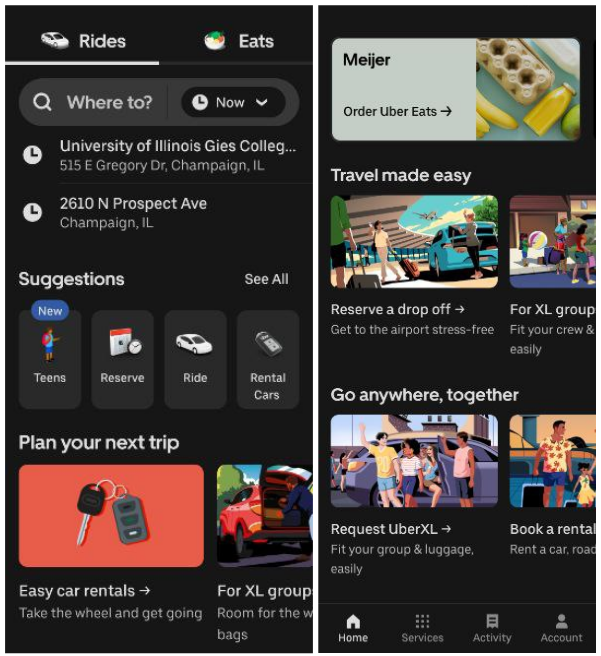

User Interface (UI) and User Experience (UX) Evaluation: Uber
Uber’s mobile app is known for its sleek and intuitive design, which contributes to a positive user experience. The platform provides a consistent, visually appealing interface that focuses on ease of use, minimizing the friction between the user and the service.
Ease of Navigation
Clear Structure: Uber’s app is structured with simplicity in mind. Users are immediately presented with a map that shows nearby drivers and an option to enter their destination at the top of the screen.
Minimalistic Design: The layout is clean, with only essential options visible to the user, reducing cognitive load. Menus and features are organized logically, making booking a ride or accessing food delivery services easy with just a few taps.
Bottom Navigation Bar: A bottom navigation bar shows us all the services in one place.
Challenges
Crowded Options: With the addition of new features like Uber Pass, Uber for Business, and Uber Rentals, the app can feel slightly cluttered for users unfamiliar with the platform.
Feature Discoverability: Some lesser-used features are harder to find, which could reduce engagement with these services.
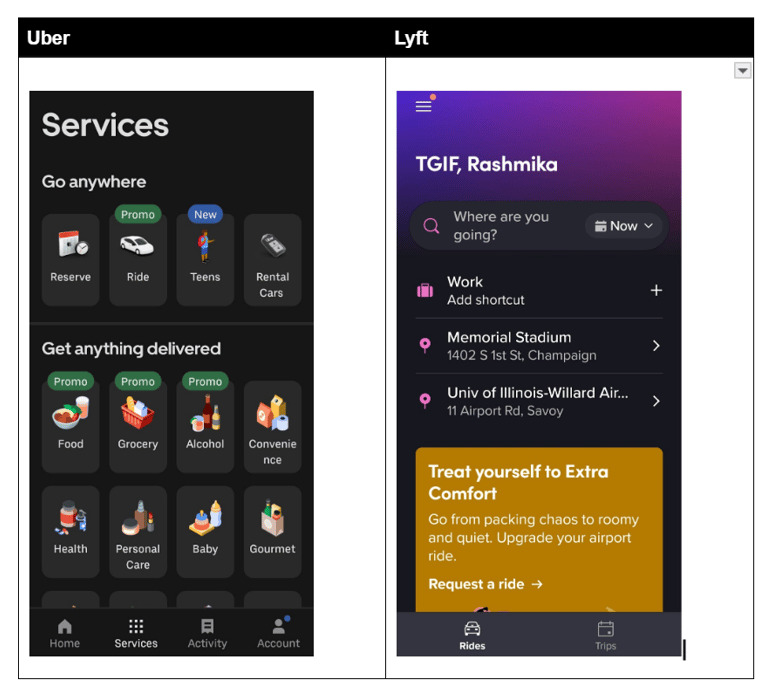

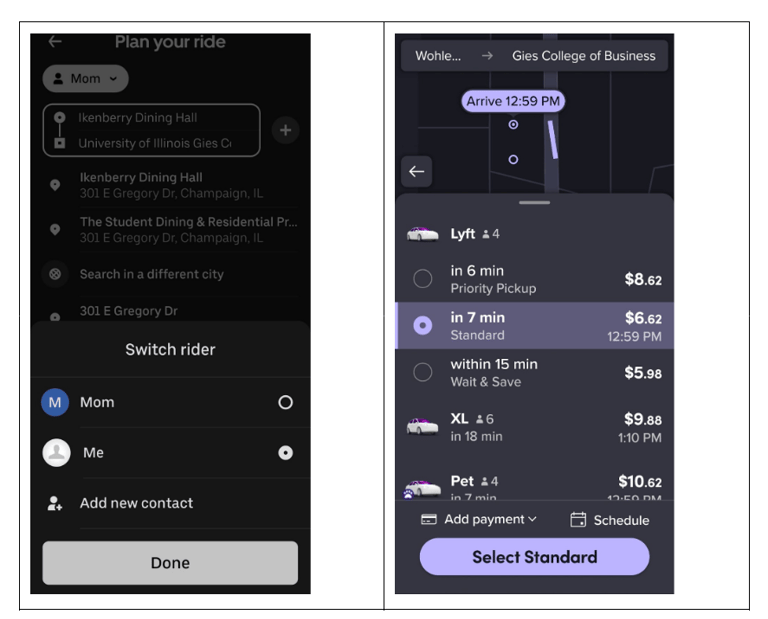

Visual Design
Modern & Consistent: Uber’s app maintains a modern aesthetic with consistent use of icons, typography, and color schemes (black, white, and green). The design contributes to a premium feel while being approachable to everyday users.
Map-Centric UI: The map is central to the app's visual design, helping users understand their location relative to nearby drivers. This dynamic element adds to the visual engagement.
Transparent Pricing: The upfront pricing model is displayed clearly with ride options, making it easy for users to make informed decisions.
Challenges
Over-Reliance on Map: While the map-centric design enhances functionality, it might overwhelm users who are simply browsing and not actively booking a ride.
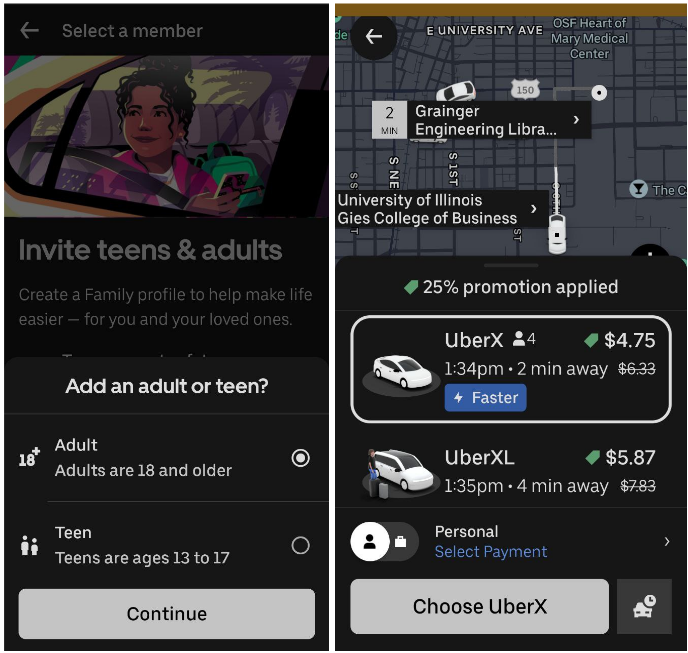

User Engagement and Usability
Quick Access to Essential Features: The app is designed for fast decision-making, allowing users to book a ride, order food, or schedule rentals within seconds.
Personalization: Uber’s app tailors content based on usage history, offering users frequent destinations and personalized promotions, contributing to higher engagement.
Seamless Experience Across Services: Users can easily switch between ride-hailing and Uber Eats without leaving the app, promoting cross-service use and engagement.
Challenges
Multi-Feature Complexity: As Uber expands its features (Uber Pass, rentals, electric rides), some users may feel overwhelmed with the number of services offered in one app, potentially impacting overall usability.
Loading Times: At times, loading maps and ride options can take a few seconds, which can create a delay in decision-making.
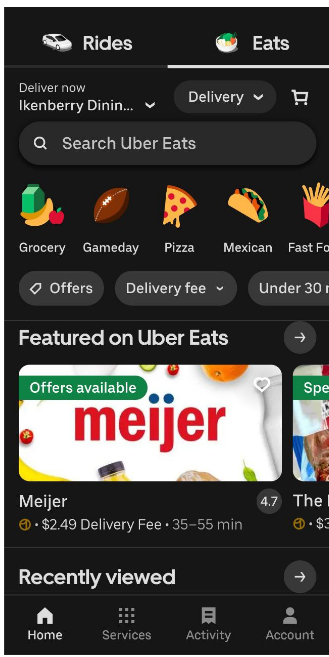

How It Meets User Expectations
Consistency Across Platforms: Uber’s UI remains largely the same whether on iOS or Android, creating a familiar and dependable experience across devices.
Focused on Core Use Cases: The app is built for people who need quick transportation or food delivery solutions, and the flow from booking to completion is seamless.
Where It Falls Short
Feature Overload: While useful for frequent users, the numerous options and services available in the app can overwhelm new or infrequent users.
Limited Customization: Users looking for more control over their experience (e.g., preferred drivers, advanced ride preferences) might find Uber lacking in personalized controls beyond the basics.
Market Fit and Competitive Analysis: Uber vs Competitors
1. Uber’s Market Position
Uber has established itself as a dominant force in the transportation and logistics space, leveraging its global presence and multi-service offering to cater to diverse user needs. Starting as a ride-hailing platform, Uber has since expanded into food delivery (Uber Eats), rental cars (Uber Rentals), and corporate transportation services (Uber for Business). This diversity allows Uber to offer an integrated experience that helps it maintain a high degree of market penetration and retention across various segments.
2. Comparison with Top Competitors
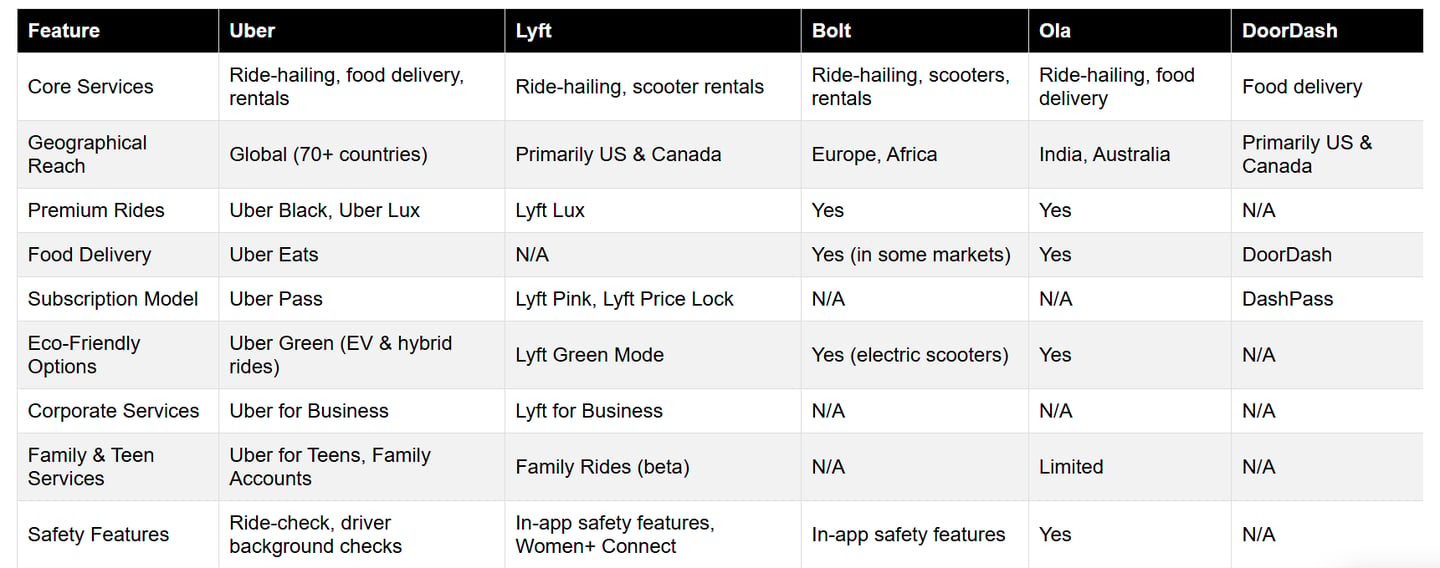

3. Pricing
Uber uses upfront pricing, which provides a transparent fare for riders before booking. This transparency helps build trust and allows users to make informed decisions. Uber's pricing, however, can fluctuate significantly due to surge pricing during high-demand times, which is comparable to competitors like Lyft.
Lyft offers a Price Lock feature for frequent riders, which provides more consistent pricing, reducing the impact of fare spikes due to demand.
Bolt and Ola both focus on affordable pricing in their respective regions (Europe, Africa, India, and Australia), giving them a competitive edge in markets where cost is a primary concern.
Uber Pass offers users discounts on both rides and food deliveries, similar to Lyft Pink and DashPass from DoorDash.
4. Uber’s Unique Selling Points (USPs)
Integrated Services: Uber offers multiple services within one app—ride-hailing, food delivery, car rentals, and corporate transportation. This makes it a convenient, one-stop solution for users with varying needs, which most competitors like Lyft or Bolt do not offer in such depth.
Global Reach: Uber operates in 70+ countries, giving it a much larger geographical footprint than its competitors like Lyft (primarily in North America) or Bolt (limited to Europe and Africa).
Uber for Teens: This feature caters to a niche family-oriented audience by allowing teens to travel independently with parental consent and control. Lyft and other competitors do not offer a similar feature.
Uber Eats Integration: Uber’s food delivery service, Uber Eats, is fully integrated into the same app, allowing users to switch between ride-hailing and food delivery seamlessly. Competitors like Lyft don’t offer food delivery, and competitors like DoorDash are limited to food delivery without a ride-hailing option.
Family Accounts: Uber allows families to share rides and manage expenses together, a feature most competitors lack. This caters to families looking for convenient group transportation solutions.
Uber Green: Uber’s commitment to promoting eco-friendly rides (electric and hybrid vehicles) is more pronounced compared to Lyft’s Green Mode, offering environmentally-conscious users an alternative.
Uber for Business: This service streamlines corporate travel management, offering features such as centralized billing and reporting, positioning Uber as the preferred choice for business clients.
5. Competitors’ Differentiators
Lyft: Women+ Connect is a standout feature, offering female and non-binary riders the option to be matched with drivers of similar identities. Additionally, Lyft's Price Lock subscription model offers more consistent pricing for frequent users, while Uber’s pricing can fluctuate more unpredictably.
Bolt: Focuses on affordability and offers ride-hailing at lower costs than Uber in markets like Europe and Africa, making it highly competitive in price-sensitive regions.
Ola: Expanding rapidly in India and Australia, Ola leverages its local market dominance to compete with Uber, especially with a lower price point in ride-hailing and food delivery.
6. Value Proposition
Uber’s value proposition lies in its comprehensive service ecosystem, offering users a range of transportation solutions, from basic rides to luxury services, as well as food delivery and rentals—all in one app. Uber also leverages its global reach, making it a convenient choice for users who travel frequently across different regions.
However, Uber's dynamic pricing and occasionally cluttered interface due to a wide array of services can make it less user-friendly for some. Competitors like Lyft focus more on simplicity and targeted safety features, which appeal to specific user segments.
Personas
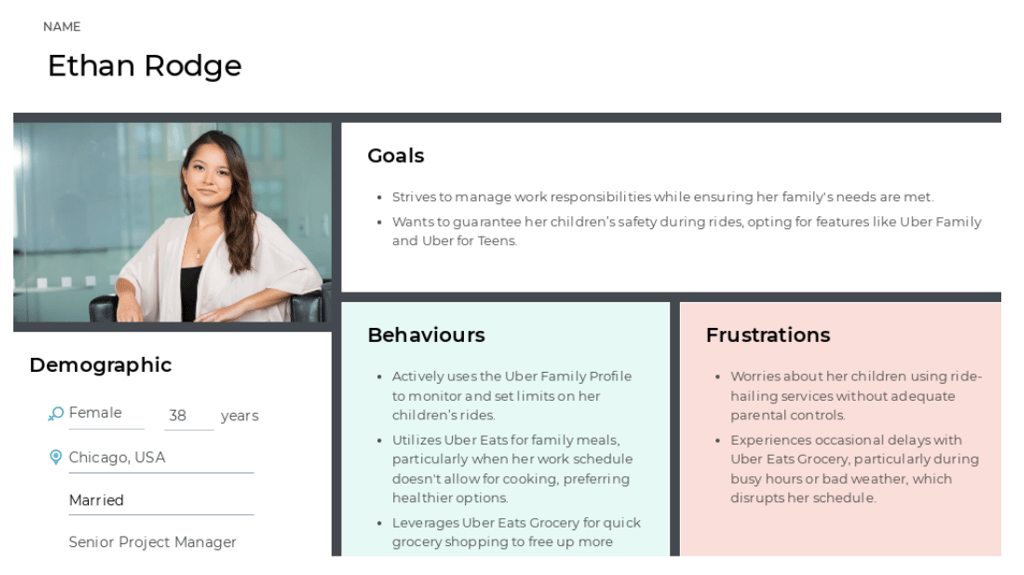

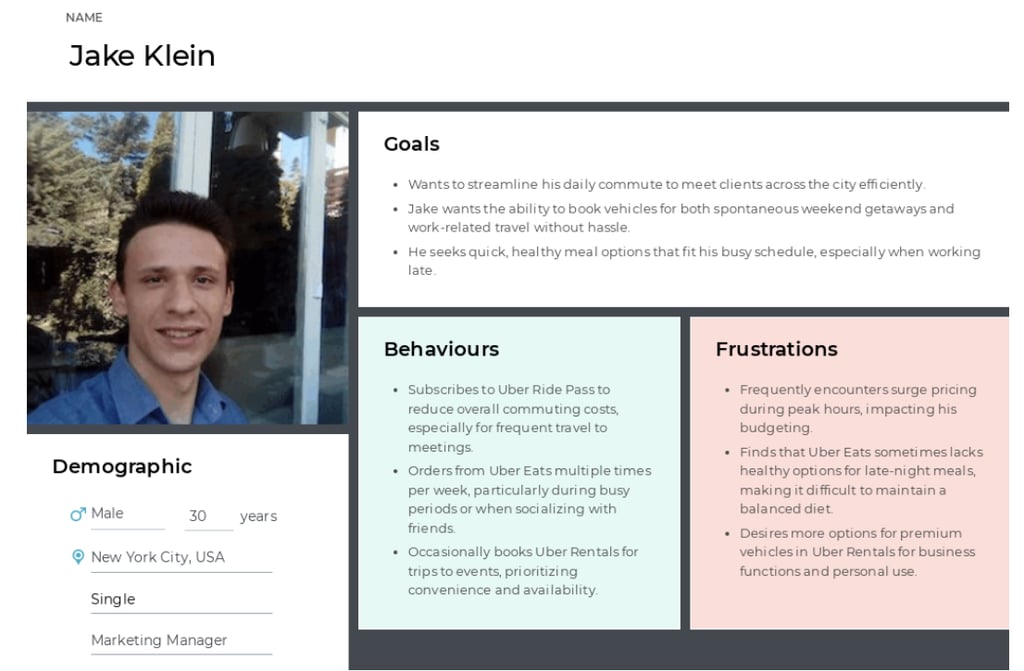

Part 2: SWOT Analysis of Uber
Part 3: Suggestions for Improvement for Uber
Based on the teardown and SWOT analysis, several areas for improvement have been identified that can enhance Uber's market position and user satisfaction. Here are detailed suggestions along with relevant examples from competing products:
1. Simplify User Interface (UI) and User Experience (UX)
Recommendation: Redesign the app to streamline navigation and reduce clutter. Utilize a more intuitive layout that highlights the most used features like ride-hailing and food delivery prominently, while secondary features are accessible but not overwhelming.
Example: Lyft has a clean interface that focuses on the ride-hailing feature, ensuring that users can quickly request a ride without distractions. Implementing a similar strategy can enhance user experience for both new and returning users.
2. Focus on Safety Enhancements
Recommendation: Expand safety features to include options like Women Connect+, a ride-sharing feature specifically designed for women, where female drivers can be matched with female riders, and additional safety protocols (e.g., emergency contact alerts, ride tracking) can be integrated.
Example: SafeRide by Lyft allows users to share ride details with trusted contacts in real-time. Uber can implement similar features to enhance user trust and safety perceptions.
3. Promote Sustainability Initiatives
Recommendation: Increase partnerships with electric vehicle manufacturers and local governments to incentivize drivers to use electric vehicles. Implementing a carbon offset program for riders could also appeal to environmentally conscious users.
Example: Bolt promotes its sustainability efforts by encouraging eco-friendly transportation options. Uber can take a more aggressive stance in marketing its commitment to green initiatives, potentially attracting a new user base.
4. Improve Family and Group Features
Recommendation: Enhance features tailored for families, such as an improved Family Account that includes functionalities like shared ride requests, expense tracking, and the ability to see ride history for all family members. Additionally, consider introducing a Group Ride feature that allows users to plan and coordinate rides together.
Example: Ola's Family Account allows family members to manage rides collectively, making it easy for families to coordinate. Uber can enhance its existing family features to provide greater value and convenience.
5. Diversify Marketing and Communication Strategies
Recommendation: Create targeted marketing campaigns focusing on specific demographics, such as college students, families, and professionals, highlighting features that cater to their unique needs. Regularly gather user feedback through surveys and focus groups to adapt features and services accordingly.
Example: DoorDash uses demographic-specific promotions (like discounts for college students), allowing them to effectively reach and engage specific user segments. Uber could implement similar strategies to enhance user engagement and loyalty.
6. Integrate Loyalty Programs
Recommendation: Develop a more robust loyalty program, such as Uber Pass, that rewards frequent users with discounts, priority support, and exclusive offers on both Uber and Uber Eats services.
Example: Starbucks Rewards incentivizes frequent customers with points redeemable for free products. A similar approach in Uber can drive user engagement and retention by rewarding loyal customers.
CONNECT
Let's collaborate and bring your vision to life.
COLLABORATE
© 2025. All rights reserved.